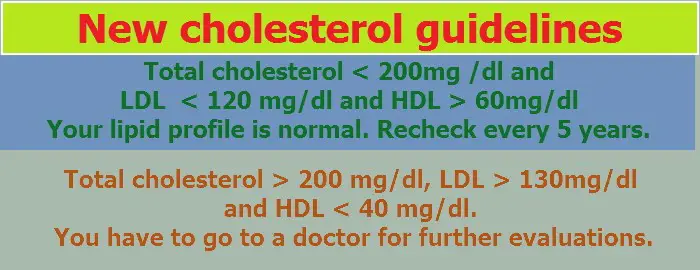
What are Cholesterol Guidelines in general? What about new Cholesterol Guidelines? Comparison between old and new Guidelines? What Natural steps to take to keep Cholesterol numbers within normal range?
Cholesterol guidelines are statements containing the criteria regarding diagnosis, management, and treatment of patients with increased levels of cholesterol.
Given that cholesterol increases the risk of cardiovascular events and stroke, it is very important a proper management of hypercholesterolemia.
The goal of cholesterol guidelines is not just the measurement and treatment of high levels of cholesterol, but even identifying whether a person has the risk of developing cardiovascular events or stroke due to hypercholesterolemia and if he could benefit from the treatment.
The guidelines highlight the most effective treatments that lower blood cholesterol and also, are considered the best strategies in the matter.
What about new cholesterol guidelines ?
The new cholesterol guidelines recommended by the American Heart Association and American College of Cardiology aim to prevent and treat high cholesterol without excessive use of statins.
The following are the recommended guidelines according to the results taken by the blood test (the lipid profile):
1. Total cholesterol less than 200mg /dl and LDL less than 120 mg/dl and HDL above 60mg/dl – your lipid profile is normal. Recheck every 5 years.
2. Total cholesterol above 200 mg/dl, LDL above 130mg/dl and HDL under 40 mg/dl – you have to go to a doctor for further evaluations.
The treatment plan of increased levels of cholesterol:
Heart-healthy diet and lifestyle
- A healthy diet
- Everyday exercising
- Maintaining a healthy weight
- No smoking.
- Taking good care of other health problems/diseases you might have ( like diabetes, HTA, obesity etc) if associated with hypercholesterolemia, they can highly increase the risk of cardiovascular effects or stroke)
For some people, these lifestyle changes are enough. But, for some people, especially for those with very high cholesterol levels, taking medications is necessary.
1. Medications.
There are two types of lowering-cholesterol medications: Statins and non-statins.
I- The statins provide the greatest benefit with the fewest side effects. Statins are used if you have at least one of these conditions:
1. Atrosclerotic-cardio-vasculary disease
2. Very high LDL-cholesterol (190mg/dl or higher)
3. Type 2 diabetes
4. The age between 40 and 70 years old.
In certain cases, considering the overall health and other factors, the doctor might still prescribe statins, even if one does not fit into one of the groups specified above.
Based on the guidelines, these cases include
1. Family history of premature heart-attack or stroke
2. Your lifetime risk of ASCVD (atherosclerotic-cardio-vascular disease)
3. LDL –cholesterol >160mg/dl with prior cardiac events
4. Hs-CRP >2
5. Results from other special testing (CAC scoring, ABI)
Finding the right dose of the statin is very important :
1. People who have had heart-attack , stroke or any other type of ASCVD benefit the most by taking the highest dose of statins. This is more appropriate than taking multiple medications
2. For people with ASCVD that are over 75 years old is more appropriate giving a more moderate dose of statins.
Sometimes a statin must be tried before deciding what dose works best.
If you are over 75 years old, and have not had a heart attack, stroke or any other type of ASCVD the doctor has to decide whether a statin is right for you.
II -The non-statins medications include:
- Bile-acid sequestrants
2. Niacin
3. Fibrates
4. Ezetemibe
The non-statin medications are recommended if:
1. The person has side effects from statins
2. Cannot tolerate the ideal dose of statins
3. Takes other drugs that interact with statins
Comparison between old and new guidelines?
There are some changes that are made in the new cholesterol guidelines, changes that include both medications and the lifestyle changes.
The most drastic change made in the new cholesterol guidelines includes the risk assessment tool.
There are no more specific numeric targets- for instance that the total cholesterol should be optimally under 200 mg/dl, or that the LDL level should be under 130 mg/dl. The new guidelines emphasize that the treatment should no longer be tailored to “the numbers”, but other factors should also be taken into consideration.
The new focus is in four high-risk groups, for whom statins are recommended :
1. People with pre-existing CVD(cardio-vascular-disease) such as heart-attack, angina, stroke or TIA (transient-ischemic attack)
2. People ages 40 to 75 who have diabetes
3. People with very high LDL-cholesterol (190mg/dl or above)
4. People ages 40 to 75 without CVD or diabetes who have a 10-year risk of CVD at least 7.5%
Also, the new guidelines recommend only statins, because the non-statin medicaments are unproven of benefit against CVD and thus, should be considered only for people who do not tolerate statins.
Changes made in the lifestyle- the new guidelines eliminate warnings about dietary cholesterol, which for decades has been blamed for causing heart-diseases. The latest guidelines state: “cholesterol is not a product of concern for overconsumption “
What natural steps to take to keep cholesterol numbers within normal range?
The natural steps that help keeping the cholesterol numbers within normal range are the lifestyle changes:
1. Eating a healthy diet- eliminating the saturated –fat –foods (red meat, butter, crème, butter) and eating low-saturated fat foods (fruits, all vegetables , seeds)
2. Keeping a normal body weight.
3. Quitting smoking if smoker. Non-smoking
4. Physical activities like walking, running, swimming, riding a bicycle etc.
5. Taking care of the health- If you have other diseases that increase the risk of CVD (diabetes, HTA, former-stroke etc) taking very good care of the situation.
